The ASUS Republic of Gamers G751 Review: G-SYNC Comes To The Notebook Computer
by Brett Howse on July 29, 2015 8:30 AM ESTGaming Performance
As a gaming laptop, this may be the only page of the review that matters to some people. The NVIDIA GTX 980M has graced our test bench several times already, and unsurprisingly it is very potent. ASUS has shipped the 4GB model, whereas MSI has the 8GB GTX 980M in the GT72 and GT80 SLI models. At the 1920x1080 resolution of these systems, 4GB should not be an issue for the moment, and as Ryan brought up in the R9 Fury X review, it is really when gaming at UHD where you may run into a VRAM limit. With the performance available from a GTX 980M though, gaming at UHD is going to be possible without some of the settings turned down. This shouldn’t be an issue though unless you are going to hook the G751 up to an external UHD monitor.
Our standard notebook GPU workload starts with some synthetics, then moves to our gaming tests.
3DMark
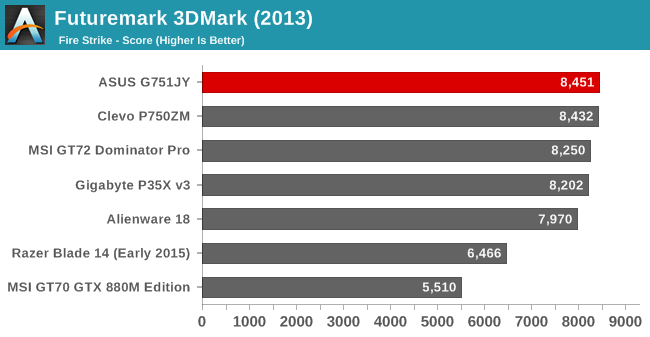
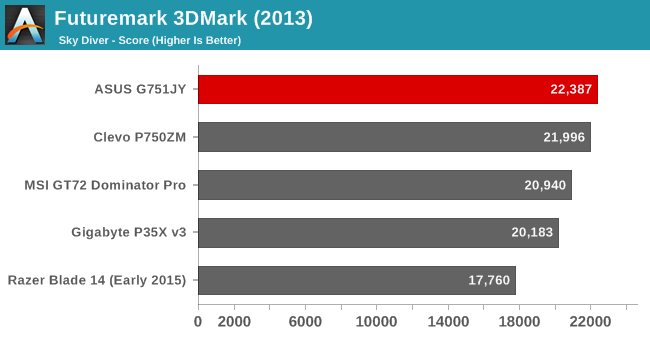
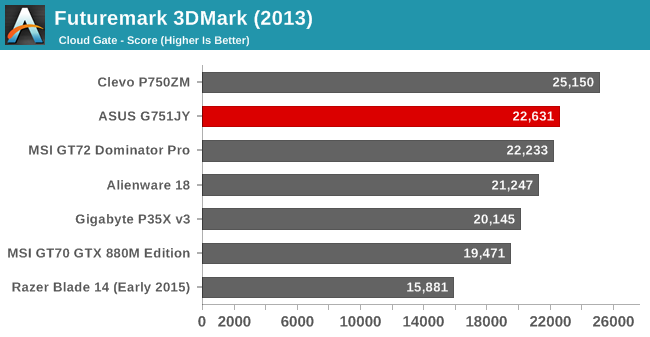
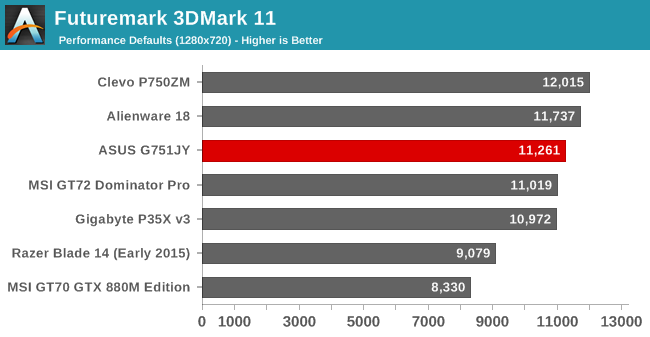
The G751 is off to a good start, scoring right in line with the other devices with a GTX 980M. As a synthetic test, it focuses several of the tests on the GPU and a couple of the physics test are handled by the CPU.
Bioshock Infinite
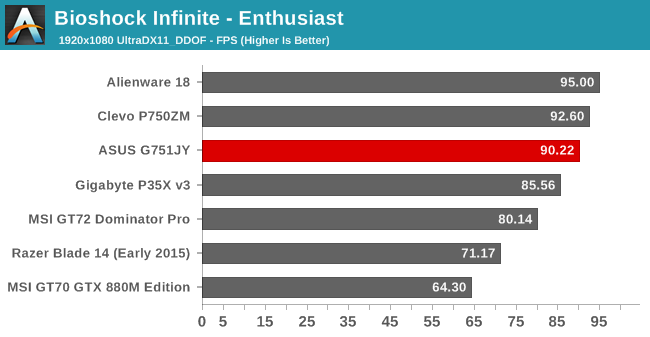
Bioshock Infinite is getting a bit long in the tooth now, but it is really a fantastic game so it will be sad to see it go. We like to keep a couple of older games like this around though in order to see performance trends over time. The G751 has no issues with this test at 1920x1080, scoring 90 frames per second as an average. This is well over the 75 Hz panel refresh rate, but G-SYNC might still be useful here in areas where there is a lot of action going on at the same time.
Tomb Raider
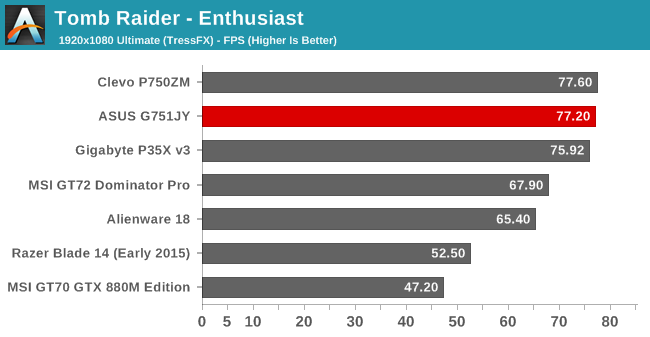
I am quite excited to see the sequel to this game, which was a fantastic reboot of the Lara Croft franchise. Our enthusiast settings for this game include TressFX, which can be fairly punishing to a lot of GPUs. The G751 scores quite well again though, coming in with an average of just over 77 frames per second. This is awfully close to the 75 Hz refresh of the panel though, so in this title, G-SYNC would be very useful. I spent some time running around the environment and came away impressed with how smooth the gameplay is with G-SYNC turned on.
GRID Autosport
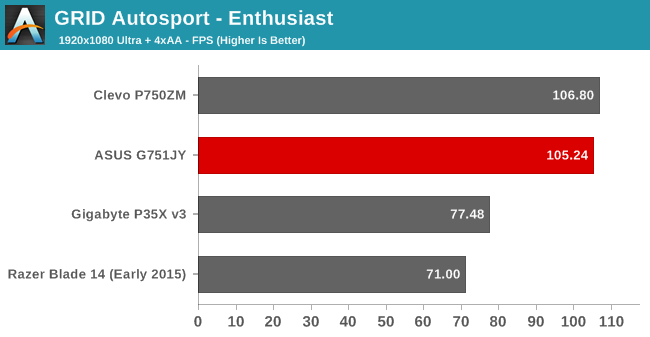
This is a new addition to the test suite for 2015, and it is the latest GRID game from Codemasters. SLI doesn’t seem to help as much in this game, but the G751 scores very well, coming in close to the Clevo which is pushed ahead by its desktop CPU.
Civilization: Beyond Earth
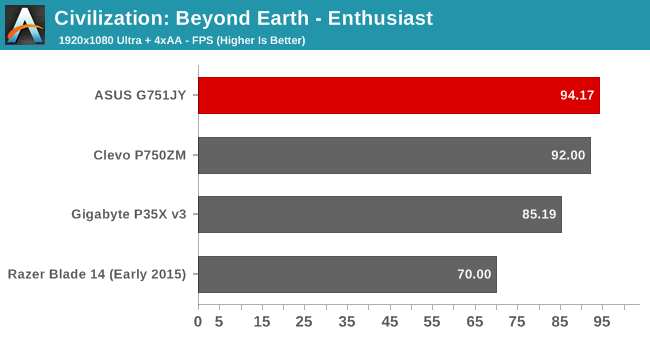
Another new addition to the test suite for 2015 is the latest turn-based strategy game based on the classic Sid Meier’s Civilization franchise. Once again the G751 has a good showing, edging out the other single GPU based systems in this test.
Shadows of Mordor
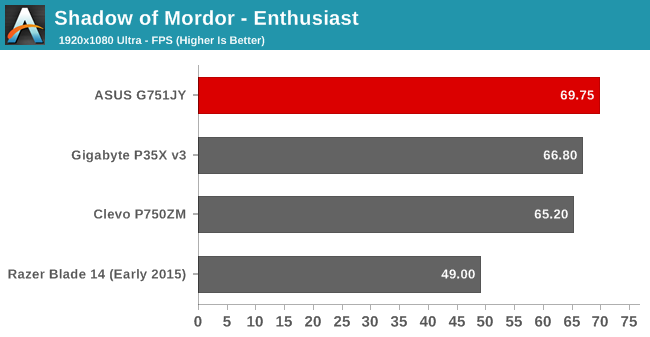
With this game set at Ultra quality, it falls just under the panel refresh rate, so G-SYNC would be well suited to this game. The G751 once again outscores all of the other single GPU systems in this test, despite having less VRAM available. This game is certainly one that can chew through VRAM, but only if the resolution is quite high.
Dragon Age: Inquisition
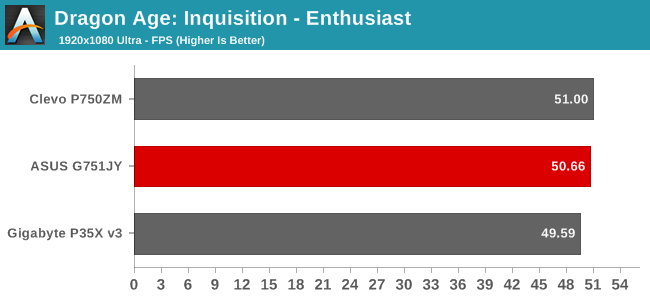
Next up is the fantastic RPG from Bioware. On a side note, I just finished this game and for me, it ranks up there with the best RPGs ever. At maximum settings, the graphics can be fairly demanding, and the average framerate of just 50 frames per second is really the first that is well under the 75 Hz refresh rate of the panel. G-SYNC would be a big benefit in this game, allowing you to keep the settings at Ultra but still be nice to play.
DOTA 2
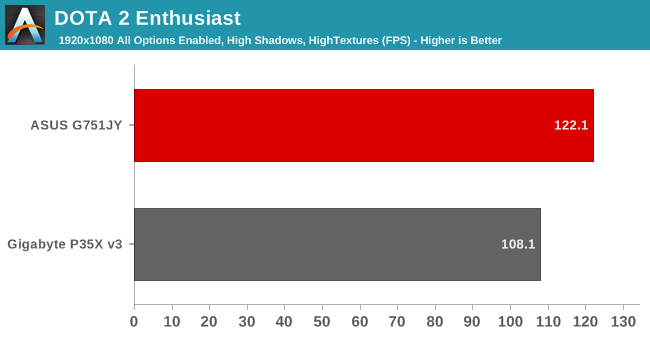
DOTA 2 was added to the test suite since it is a game that is well suited to being played on an integrated GPU, but those systems can struggle for framerate when you max out all of the quality settings at 1080p. A system with a dedicated GPU is going to be much better as you can see from the scores.
GPU Summary
Closing out the GPU results, the G751 scores right in line with the other GTX 980M systems despite it being the first one we’ve tested with 4GB of VRAM. At the lower resolution that large display notebooks seem to be stuck in, 4GB is likely not going to be an issue. The cooling system had no problems in any of these tests, allowing the CPU and GPU to maintain higher frequencies and edge out some of the other systems.










52 Comments
View All Comments
Meaker10 - Wednesday, July 29, 2015 - link
Indeed, the only way to get around this is to do what MSI have done and have a manual switch and on reboot move the traces over and run in IGP mode (without G-sync of course).Asus also only had the later G750 with optimus, before they actually avoided it generally in their 17 inch models. So really for asus the optimus models were a blip rather than a trend.
nerd1 - Friday, July 31, 2015 - link
Many laptops had hardware mux to switch GPU pre-optimus era (alienware had one) which is a way better solution than optimus.nightbringer57 - Wednesday, July 29, 2015 - link
As a matter of fact, everyone has been building some non optimus notebooks all the time.The Optimus technology requires the screen to be directly driven by the integrated GPU. Some custom technologies made by GPU manufacturers require the screen to be driven by the GPU himself. That's why the 3D laptops never sold, because Nvidia's 3D technology requires the screen to be driven by the nvidia GPU directly, so you can't have an Optimus-enabled 3D screen laptop (well, at least using nvidia 3D).
The same problem is true for G-Sync. So you can't technically have G-sync and optimus on the same laptop.
BMNify - Wednesday, July 29, 2015 - link
Exactly, the optimus tech even effects VR and you can't drive VR with igpu, many high end laptops are now coming without optimus due to customer demand.BMNify - Wednesday, July 29, 2015 - link
Optimus tech is reviled in the hardcore gaming community and gaming forums who pay $2000 plus for gaming laptops, many top-end gaming laptops have no optimus due to Customer demand !!Notmyusualid - Saturday, August 1, 2015 - link
^ This is true.Many don't buy a machine due to the very fact that Optimus is there.
However, I have a Dell M3800 HD4600/K1100M that has no issue with it.
boeush - Wednesday, July 29, 2015 - link
OK, bit why would anyone buy this now, when Skylake is right around the corner? Wait another couple of months, and an equivalent model with a better CPU and DDR4 is all but guaranteed by the holiday shopping season. Or, at the very least, this particular model will be selling at deep discounts by then...boeush - Wednesday, July 29, 2015 - link
Not to mention, a premium laptop this far into 2015, and with not a single USB 3.1 port? Tsk, tsk...meacupla - Wednesday, July 29, 2015 - link
because, you buy it when you need it, not when there is something new 'in a couple of months'.A week, sure, that's not a long wait, but 2 months to launch means you're going to be waiting another 6 months until the replacement for this type of gaming laptop to appear on the market.
boeush - Wednesday, July 29, 2015 - link
According to various leaks, Skylake H is launching in October. Skylake T (low voltage 35W i7 6700) is also launching about then or even sooner.Given that, why would anyone NOT expect all brands to refresh models with Skylake by Black Friday?? Any brand that fails to do that, is going to lose out huge this year.
So sure, retail availability of bixed CPUs is October, but I'll bet all the OEMs have had samples under NDA since spring, and are working to deliver updated models on the same day as the CPU launch.